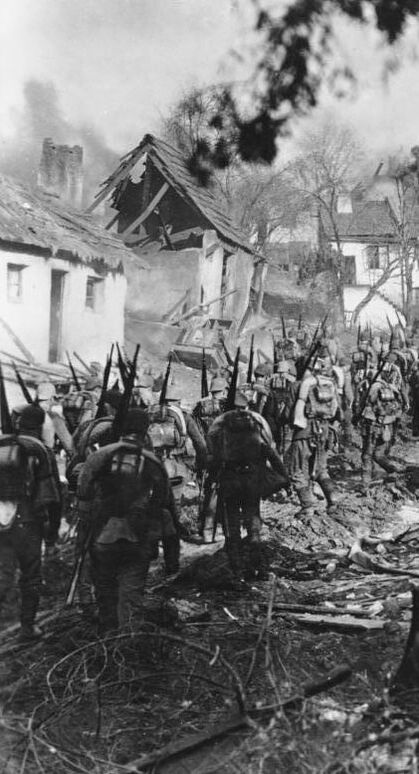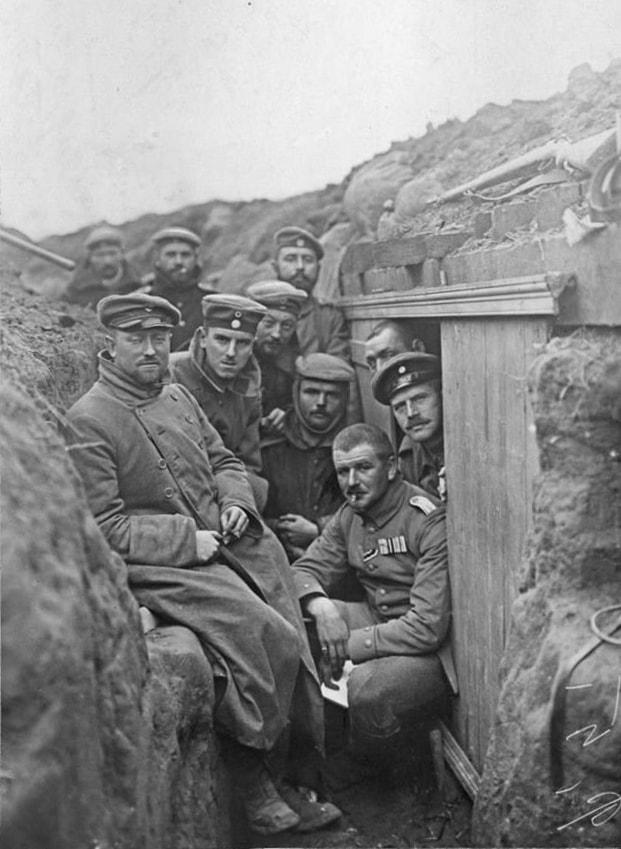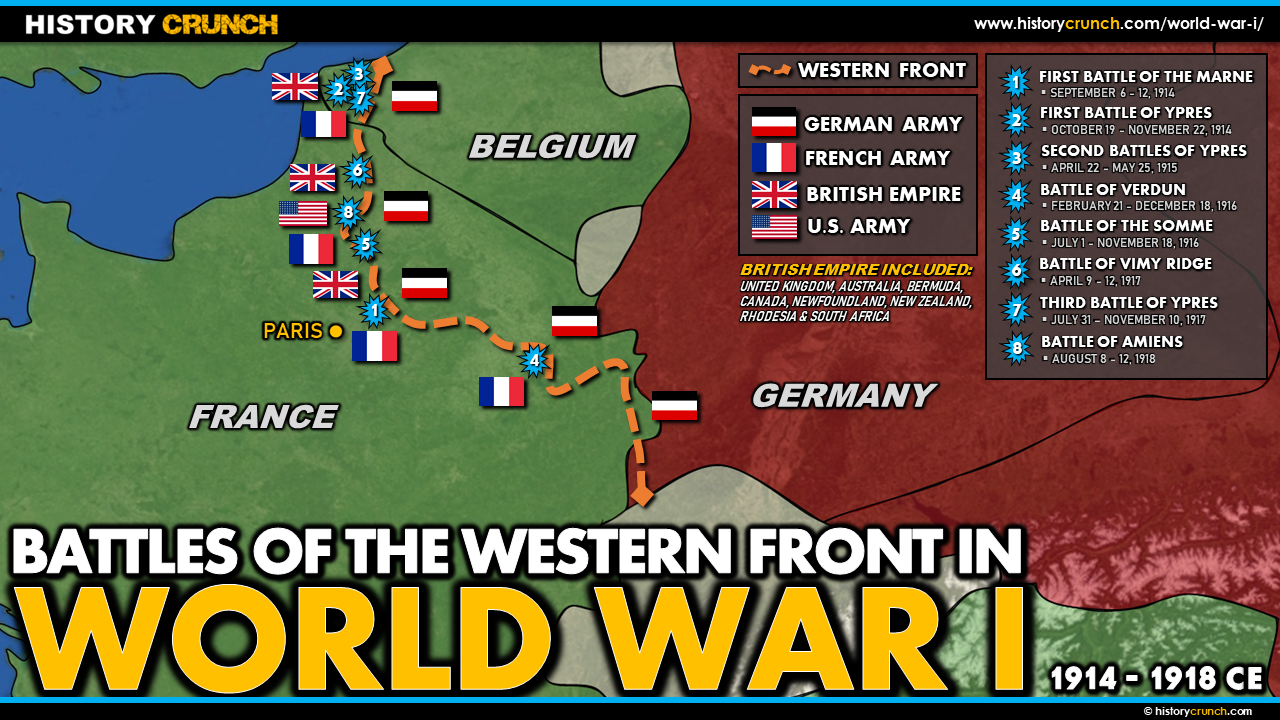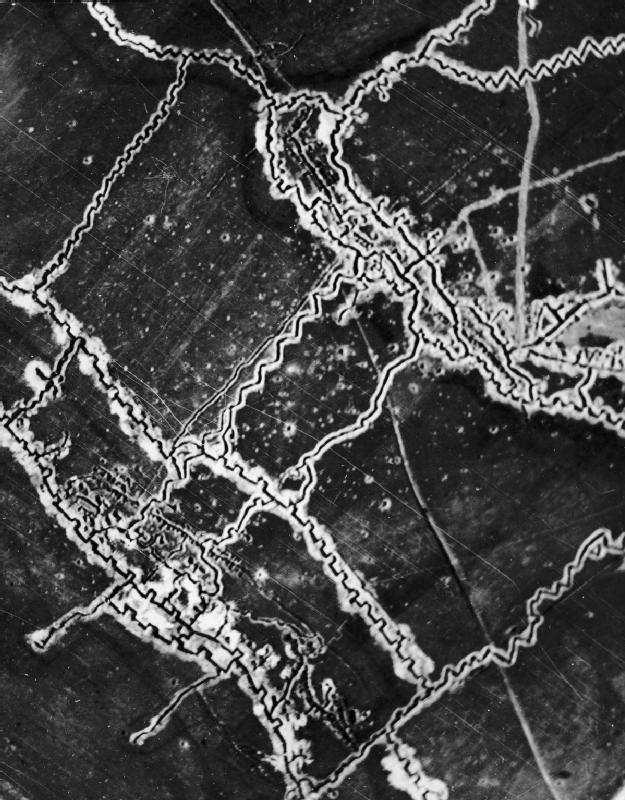
An important aspect of the German war effort in World War I was the Schlieffen Plan. The Schlieffen Plan was the German plan of attack at the beginning of the war and was designed by and named after the former Germany Army Chief of Staff, Alfred von Schlieffen. He had been asked to design a plan of attack to help ensure German victory at the outbreak of war in Europe. Since Germany was facing both France and Russia in World War I, Germany would have to deal with a two-front war and the possibility of its total armed forces being split to fight on both its western and eastern borders. The Schlieffen Plan was Germany’s response to this problem and at its heart, the Schlieffen Plan was designed to prevent Germany from being forced to fight a two-front war. Essentially, the goal was for Germany to knock France out of the war as quickly as possible and then to refocus its attention onto Russia in the east. The Schlieffen Plan was based on the idea that Russia would take much longer to mobilize and therefore not be ready for war until after the first two weeks. As a result, Germany sent almost all of its Army divisions to the Western Front and much less to the Eastern Front. While Germany was primarily concerned with the major battles of the Western Front, the first important battles of World War I that they participated in was the Battle of Tannenberg, which occurred on the Eastern Front.
The Battle of Tannenberg took place from August 26th to August 30th in 1914 and was fought between Germany and Russia. The battle took place in East Prussia on the eastern half of the German Empire. In general, the Battle of Tannenberg was one of the most significant battles of World War I, and an important victory for the German Army. More specifically, the German Eighth Army, which was commanded by Paul von Hindenburg and Erich Ludendorff, was able to surprise attack and overwhelm the Russia forces that had attempted to invade East Prussia. The Russian forces were divided into two armies – the First Army commanded by Paul von Rennenkampf and the Second Army, which was commanded by Alexander Samsonov. During the Russian attack into East Prussia, Rennenkampf’s army advanced northeast while Samsonov’s army advanced southwest. This was problematic, as the two were unable to communicate effectively. As such, the German command used this to its advantage and on the 26th of August the German Eighth Army began its surprise attack against Samsonov’s forces. During the battle, Samsonov and the Russian Second Army were effectively surrounded and bombarded with German artillery fire. Although Samsonov tried to order a retreat, the German attack proved to be too much for the Russian forces and led to the Battle of Tannenberg being a major defeat for Russia. In fact, of Samsonov’s Second Army, 92,000 were captured, 78,000 were killed and only about 10,000 escaped. Furthermore, Samsonov killed himself after realizing that his army was destroyed. As well, Rennenkampf’s army failed to assist Samsonov’s due to a failure in communication, and were eventually forced out of East Prussia. The Russian failure at the Battle of Tannenberg was so devastating the Russian Army that it did not invade Germany again for the rest of World War I.

As stated above, the primary focus of the German Army, at the start of World War I, was to quickly defeat France as part of the Schlieffen Plan. As such, while the Battle of Tannenberg was a major victory for Germany, its battles on the Western Front were much more strategically important to the overall German war effort. The first important battle that Germany participated in on the Western Front was the First Battle of the Marne.
The First Battle of the Marne occurred from September 6th to the 12th in 1914 and was one the first major conflicts of World War I. The First Battle of the Marne is significant for how French forces were able to stop the advancing German Army before they reached Paris. The battle saw defending French troops stop the German Army from carrying out the Schlieffen Plan and led to trench warfare in Northern France. Eventually, the German forces were stopped at the Marne River just 30 miles from capturing the French capital. It is estimated that the French and the Germans each suffered 250,000 casualties at the First Battle of the Marne. Germany also suffered over 67,000 deaths in the battle. While it is remembered as a victory for the Allied forces, it is also the event that led to the continued stalemate of trench warfare that remained on the Western Front for the rest of the war. For instance, the famous ‘Race to the Sea’ occurred immediately following the First Battle of the Marne.
The ‘Race to the Sea’ occurred throughout September and October of 1914. The German Army was successfully stopped at the First Battle of the Marne in early September and each side raced north in an attempt to flank the other. British and French forces countered the German push north throughout September and October until the two sides reached the North Sea in Belgium on October 19th. What resulted was a line of trenches that extended throughout much of northern Belgium and France. It was along this line of trenches that some of the most significant battles of World War I took place.

The next significant battle for the German forces in World War I was the First Battle of Ypres, which took place from October 19th to November 22nd in 1914. The battle was the result of the end of the Race to the Sea and saw the British, Belgian and French forces engage in battle with the German forces. The battle was deadly on all sides and led to numerous casualties. For instance, it is estimated that Germany suffered as many as 130,000 casualties in the battle. In all the battle was characteristic of the conditions at the time, in that defensive fortifications ensured numerous dead and injured with little or no results. Ypres is a town in western Belgium that saw intense fighting in World War I between the Allied and German forces. In fact, the region became known as the Ypres Salient and was the site of several major conflicts throughout World War I.
The next major conflict for the German Army was in the Second Battle of Ypres, which occurred from April 22nd until May 25th in 1915. At the battle, the British fought alongside French and Belgium forces against the German Army. The Second Battle of Ypres was significant because it is remembered today as the first use of poisonous gas on the Western Front. Germany introduced chlorine gas canisters into the battle on the first day of fighting, when they used the deadly gas against the Allied troops.
The Second Battle of Ypres was also significant because it saw the first time that a former colonies soldier’s defeated a European power within Europe. For example, after the German gas attack on the first day of the battle, Canadian soldiers were the primary defenders of the German flank at Ypres. Canadian soldiers defended the town of St. Julien and withstood the gas attacks by the German soldiers. Regardless, Allied soldiers, despite facing heavy gas attacks and German advances, were mostly able to hold back the German advance and prevent Germany from making inroads into Allied held territory. While the battle is viewed as an Allied victory, it still cost the lives of many people on both sides. Historians estimate that the German casualties from the Second Battle of Ypres totaled over 34,000.

Next was the Battle of Verdun, which was fought from the 21st of February to the 18th of December in 1916 and is remembered as one of the largest battles of World War I on the Western Front. It was fought between France and Germany in a hilly region of north-eastern France near the city of Verdun. The Germans had hoped to capture the region and use the hills of the area as a staging ground for their artillery guns. From the top of the hills, Germany hoped to use their artillery fire to control the entire region, including the city of Verdun.
The region around Verdun had many different forts that France had defended to different degrees. The German plan, which was created by German Chief of Staff Erich von Falkenhayn, was to invade the region and begin to capture some of these French forts. This, Germany believed, would draw France into a major battle in the area and bog down the French forces in trying to defend their forts. Next, the German plan called for them to use their artillery power to bombard the French forces and overwhelm the French defenses in the region so that German soldiers could push through and capture the region and the city of Verdun. The French defense in the region would be overseen by French General Philippe Pétain, who would be seen as a war hero for his role in the Battle of Verdun.
The German assault began on February 21st and involved the German artillery launching artillery shells into the region followed by a German offensive of infantry soldiers. The German soldiers were able to capture several of the forts around Verdun, as the French defenses were weak and unable to stop the German assault. However, French troops began on strengthening the French defenses in and around Verdun and soon the French brought re-enforcements into the region to help defend. Despite coming within 2 miles of the city of Verdun, the German forces were never able to capture the city during the World War I battle. In July of 1916, the Battle of the Somme also began, which caused Germany to divert troops from Verdun to the Somme. This weakened the German offensive at Verdun to primarily an artillery attack and better allowed the French the ability to defend and even recapture many of the forts that they had earlier lost. By the end of the battle, France was able to push the Germans back and Germany had failed to achieve its goal in the region.
The Battle of Verdun is remembered today as the longest single battle in human history. The battle lasted 302 days and caused devastating casualties for both the French and the Germans. The total casualties in the Battle of Verdun were terrible. For instance, historians estimate that France suffered as many as 400,000 casualties and 163,000 deaths. As well, it is estimated that Germany suffered as many as 350,000 casualties and 143,000 deaths.
As stated above, the Battle of the Somme occurred alongside the Battle of Verdun. In fact, the Battle of the Somme took place from July 1st, 1916 to November 18th, 1916 and is remembered as one of the bloodiest battles in human history. It was a devastating battle that took place along the River Somme in northern France. It was fought between Allied Powers (France and Britain) and the Central Power of Germany and was a major conflict on the Western Front. France and Britain both hoped that by starting the Battle of the Somme, they would relieve pressure on French defenders in Verdun during the Battle of Verdun where the French were struggling against the German assault on that region. The Allied strategy at the Battle of the Somme was to draw more German troops away from Verdun and into the Somme in hopes of causing Germany to struggle with managing both large battles at the same time. The battle finally came to an end on November 18th, 1916 when the change in weather and arrival of snow made fighting even more difficult.
In the end, the Battle of the Somme was one of the deadliest battles of World War I. The total casualty count number over 1 million, with the Allied forces having over 600,000 and the German forces having over 400,000. The Battle of the Somme is one of the most notable battles of World War I due to it being such a brutal and devastating conflict.

German trenches north of Thiepval, France in May of 1916. Related to the Battle of the Somme. (Imperial War Museum)